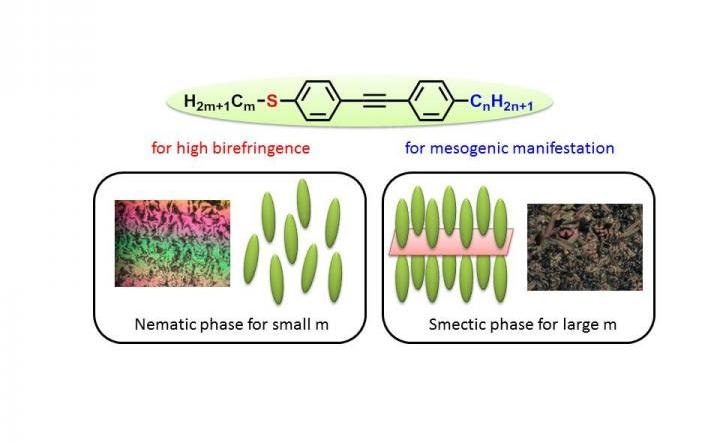Nov 28 2017
Yuki Arakawa, Assistant Professor at Toyohashi University of Technology, has headed a research team to successfully liquid-crystallize π-conjugated rod-like molecules including alkylthio groups comprising sulfur.
By achieving this, they have created molecules of high birefringence exhibiting nematic liquid crystal (LC) that has high fluidity in a temperature range that includes ambient temperature. The team anticipates that this molecular structure will present an innovative LC material that will play a vital role in the high-quality image resolution of LC displays.
 Images of alkylthio group rod-like molecules exhibiting liquid crystallinity at room temperature, and the phase structures. CREDIT: Toyohashi University of Technology.
Images of alkylthio group rod-like molecules exhibiting liquid crystallinity at room temperature, and the phase structures. CREDIT: Toyohashi University of Technology.
LC materials that have high dielectric constant and birefringence have already played a significant part in decreasing the driving-voltage and in enhancing the response speed of LC displays. In the recent past, different techniques have been adopted to use LC materials with high birefringence in broadband circularly polarized light-reflecting films for increasing the brightness, or in cholestric LC lasers to ensure constant oscillation.
With regard to practicality, LC materials have to be created by setting the orientation state of LC or by forming LC phases at ambient temperature. Yet, enhancing dielectric constant and birefringence mandates not only electron richness but also an anisotropic molecular structure, rendering an increase in the phase transition temperature, specifically the melting point, unavoidable owing to greater intermolecular forces. To sum up, it is challenging to configure a liquid crystalline state under ambient temperature.
Assistant Professor Yuki Arakawa and his colleagues were intrigued by alkylthio groups (SCmH2m+1) comprising “sulfur”— a hot springs component which Japan has in surplus. Despite the fact that alkylthio groups are highly polarizable and are anticipated to be an efficacious replacement group for enhancing birefringence, just a handful of cases of rod-like molecules including alkylthio groups that form LC have been come across thus far. This is because they are very difficult to crystallize.
Yuki Arakawa and his collaborators introduced considerably long alkyl chains including five or more carbon atoms into one of the terminals of a diphenylacetylene structure that had alkylthio groups to reveal in order to demonstrate that they exhibit liquid crystallinity at the time of the cooling stage. This is considered because of the fact that of all the molecules that are antiparallelly aligned, long alkyl groups hinder molecular crystalline packing and consequently allow the molecules to rotate and translate without altering their orientation.
This ultimately results in the formation of an LC phase. In addition, the researchers noticed a phenomenon in which there was a decrease in the melting point owing to the large bending and low electron donating characteristics of the alkylthio groups. Thus, they were successful in creating a molecule that exhibited liquid crystallinity in a temperature range that also included the ambient temperature.
When the number of carbon atoms in alkylthio groups was altered subsequent to introduction of long alkyl chains, it was feasible to form a greatly ordered smectic phase that had a high viscosity layer structure as well as a nematic (N) phase with low viscosity, which is specifically significant for optical applications. Considerable enhancement in optical characteristics was observed upon comparison with oxygen analogues.
There were only a few reports on rod-like structure molecules with alkylthio groups exhibiting liquid crystalline phases, and no studies revealed the characteristics of these molecules, including the reason why they tend not to form liquid crystalline phases. We’re now aiming to utilize the characteristics of each phase to the full to explore various optical and electronic physical properties, including not only optical properties but also semiconductor properties.
Yuki Arakawa, Assistant Professor, Toyohashi University of Technology